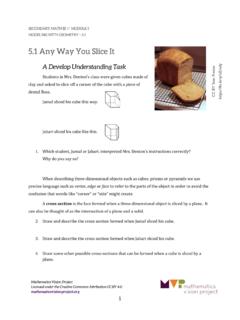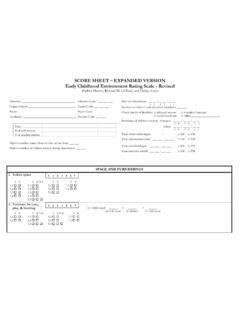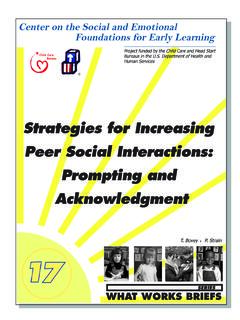Transcription of The Good and Bad of Microorganisms - Utah Education …
1 Grade BenchmarkStandardPage06 : 05 05 06 The Good and Bad of Microorganisms It happens every year, sometimes two or three times. It happens to almost everyone in every city, state, town and country around the world. When was the last time it happened to you? What? Oh, sorry! When was the last time you were sick? Did you have a fever, scratchy throat, headache, body aches or several of these symptoms? A microorganism , a living thing that can only be seen with the aid of magnification, was probably the cause ofwhatever sickness you had. You may have called it a germ, but this term only describes relatively few Microorganisms . All Microorganisms are living things or organisms. Microorganisms may be unicellular or single-celled, any living thing that has only one cell, the smallest unit of life. Some microor-ganisms are multicellular, having more than one cell. Microorganisms require food, air, water, ways to dispose of waste and an environment in which they can live.
2 Some Microorganisms are producers, living things that make their own food from simple substances usually using sunlight, as plants do. Some Microorganisms eat other organisms to get their food. Most Microorganisms do not cause disease and many are helpful. There are many different kinds of Microorganisms . Scientists observe and classify Microorganisms just as they do plants and animals. These classi-fications are determined by the Microorganisms shape, structure, how they get food, where they live and how they move. The Microorganisms you will study in this unit include bacteria, fungi, and protist. Let s look at the characteristics of each. Science Benchmark: 06 : 05 Microorganisms are those living things that are visible as individual organisms only with the aid of magnification. Microorganisms are components of every ecosystem on Earth. Microorganisms range in complexity from single to multicellular organisms. Most Microorganisms do not cause disease and many are beneficial.
3 Microorganisms require food, water, air, ways to dispose of waste, and an environment in which they can live. Investigation of Microorganisms is accomplished by observ-ing organisms using direct observation with the aid of magnification, observation of colonies of these organisms and their waste, and observation of Microorganisms effects on an environment and other 05: Students will understand that Microorganisms range from simple to complex, are found almost everywhere, and are both helpful and BACKGROUND INFORMATIONM icroscope Bacteria are microscopic, single-celled organisms that exist all around you and inside you. Although they can cause sickness and disease, they are very important to life on Earth. We depend on bacteria to help in the digestion of food, for plant growth, and to help us make foods and medicines. Bacteria are an important part of the soil. They are able to capture some nu-trients that plants cannot. When living things die, bacteria play a very important role as decomposers, bacteria and fungi feeding on and breaking down plant and animal matter.
4 With-out these decomposers, the bodies of all organisms that have ever lived would still remain. This would be messy. When bacteria break down the dead organisms, they release substances that can be used by other organisms in the ecosystem. Bacteria can affect our bodies in several ways. Harmful bacteria can make us sick, but fortunately, our bodies will fight back. When streptococcus bacteria give us strep throat we can take medicine to help us get well faster. Some bacteria always live in our bodies. They are found in digestive systems and help digest food. Other bacteria are in our food. When you eat yogurt or cheese, you eat bacteria. Bacteria are the smallest Microorganisms . You can see them when there are thousands of them growing together in a colony. To see baceria as a single organism, requires a microscope with very high magnification. Bacteria live in almost every place on Earth. Scientists can culture, grow Microorganisms in a specially prepared nutrient medium.
5 The drawing shows how colonies of bacteria look when cultured on a plate. The colonies vary in size and color depending on the type of bacteria. Fungi are organisms that are neither plant nor animal, yet have characteristics of both, and absorb food from whatever source they are growing on. A common fungus is a mushroom. It looks like a plant but is not green. Mushrooms cannot make their own food and must live on a food source. Some are poisonous, and only an expert can identify them. Another fungus, yeast, is used to make bread rise and give it flavor. Athlete s foot is caused by a fungus. Some types of fungi rot wood in homes. Fungi also like warm moist places to grow. A good way to prevent fungus is to keep things, like your toes, dry. FungiBacterial Colonies on a colonies Para- Protozoans are microscopic organisms that usually live in water. They move through the water with tiny hair-like arms called cillia.
6 The cillia are located all around the sack-like body of the protozoa and wave back and forth to move the protozoa through the water. Some protists are producers like plants. Others must eat smaller things like bacteria or molds. Protozoa are an important food source for many pond creatures. Some protozoans are harmful to people. You may have heard that it is not a good idea to drink water from a stream. Streams sometimes contain a protozoan called Giardia that can make you sick. Algae are a type of protist that usually live in water and can produce their own food. Some algae are very large, while oth-ers are microscopic. Algae can be red, brown, yellow or green. Some of the largest algae are kelp. They can grow to be 60 meters long. Algae are an important part of the ocean s ecosystem. They provide food for fish, whales and many other sea animals. Phyloplaukton provide over half of oxygen on Earth. Algae are also eaten by people.
7 In fact, algae are in ice cream. There are many important discoveries that scientists have made concerning Microorganisms . The next two stories describe how two of the discoveries were DiscoveriesLouis Pasteur Louis Pasteur was a French chemist. He is sometimes known as the father of modern bacteriology because he was able to show that bacteria exist, grow and can be controlled. Pasteur is credited with developing the process of pasteurization. He developed an investigation, a process designed to answer a question, and used an experiment, a series of steps to find the answer to a question. These are the steps of his experiment: one: Pasteur developed a hypothesis, an idea made into a statement that can be tested. Pasteur proposed that if bacteria were heated, they would die. Step two: Two jars with a culture of bacteria were three: Jar A was heated and Jar B was not. Jar A is testing the the heat, experimental vari-able, a part of an experiment that is changed in order to find out the effects of that change.
8 Jar B is not testing the heat variable. It is called the control, a part or varible of an ex-periment that is kept the same to be used for comparison. A control is needed to compare results when the experiment is four: After some time had passed, Pasteur observed that Jar A had no bacterial growth and Jar B had bacterial five: Pasteur came to the conclusion, a summary based on data related to a hypothesis, that heating kills bacteria. s Bacterial PlateAlexander Fleming It was a warm September day in 1928. Alexander Fleming was working with bacterial cultures in a London hospital. He left the windows of the lab open. After studying some labo-ratory plates of staphylococci bacteria, he accidentally left a plate by the open window and forgot about it. A few days went by. He returned and found that the plate by the window was contami-nated. Was his experiment ruined? Fleming didn t throw the plate away. He re-examined it under a microscope and found mold growing on the staphylococci.
9 He noticed a clear zone that existed all around the mold. The mold was killing the deadly bacteria. Penicillin was the mold that killed bacteria. It was Alexander Fleming s mistake that gave the world penicillin. This is now con-sidered one of the greatest discoveries of the 20th century. Fleming received the Nobel Prize in 1945, and millions of people worldwide have survived disease because of his discovery. Bacterial colonies Science Language Students Need to Understand and Use1. algae: Protists that usually live in water and can produce their own food. 2. bacteria: Microscopic, single-celled organisms that exist around you and inside conclusion: The summary of an experiment, based on data related to a culture: To grow Microorganisms in a specially prepared nutrient decomposer: An organism, often a bacterium or fungus, that feeds on and breaks down dead plant or animal experiment: A series of steps to find the answer to a fungi: Organisms that are neither plant nor animals,but have characteristics of both and absorb food from whatever they are growing on.
10 8. hypothesis: An idea made into a statement that can be investigation: A process designed to answer a microorganism : A living thing that can only be seen with the aid of organism: A living producer: A living thing, like a green plant, that makes its food from simple substances usually using protozoan: Microscopic organisms that usually live in single-celled: Any organism that has only one cell, the smallest unit of life. 15. variable: (experimental) A part of an experiment that is changed in order to find out the effects of that control: A part or variable of an experiment that is kept the same to be used for















